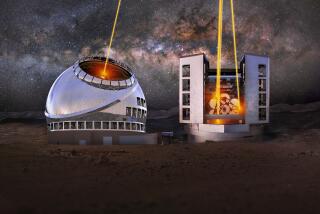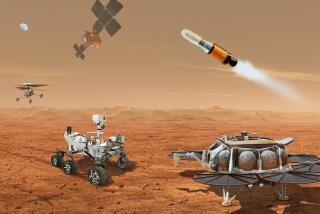Spacewalking Repair Team to Work on Hubble Flaws : Astronomy: Shower head inspires a device to improve focusing ability. Seven astronauts to lift off Wednesday.
- Share via
When NASA planned a space shuttle mission to fix the Hubble Space Telescope--the orbiting observatory hobbled by a defective mirror--the agency chose its most experienced astronauts, trained them exhaustively for 11 months and gave them 200 custom-made tools to do the job.
But once the six-man, one-woman crew begins its mission--liftoff is scheduled for early Wednesday --their most sophisticated piece of equipment will be something that was not dreamed up in a NASA research center, industry think tank or university laboratory.
It was conceived in the shower of a German hotel room.
There, nearly three years ago, while preparing to ask a European Space Agency team if it had any idea how to fix the Hubble, NASA engineer James H. Crocker encountered a shower head that extended and adjusted to accommodate bathers of almost any height.
The invention it inspired--specially ground mirrors on automated arms that reach into the space telescope’s belly and flop into place like that adjustable shower head--could do what once seemed impossible: install corrective optics to within a few millionths of an inch inside an apparently inaccessible part of a satellite 300 miles above Earth.
So much for finding a solution. Now the contraption must be installed in the freezing void of space. Two teams of spacewalking astronauts will try to wrestle Crocker’s phone booth-size optics package--and another, equally bulky device--into the 43-foot-long Hubble during the mission.
The 11-day flight--which is scheduled to include five spacewalks, one more than has been attempted on any previous mission--will be one of NASA’s most ambitious adventures. It will also be one of its riskiest, in terms of both the mission’s success and NASA’s status as a federal agency.
Although shuttle program managers downplay the need for an unalloyed success, congressional aides and other NASA watchers believe that the future of the space agency, and perhaps human space flight itself, may be at stake.
Success in repairing the Hubble would help the National Aeronautics and Space Administration repolish its reputation, which has been tarnished by a string of high-profile failures, from the fatal Challenger disaster in 1986 to last summer’s disappearance of Mars Observer to the building of the flawed Hubble telescope itself.
Failure to fix the Hubble--or, worse, blinding it by accident or by mistake--could vaporize the space agency’s credibility on Capitol Hill and almost certainly lead Congress to reassess NASA’s ability to build the much-criticized Space Station.
“Admittedly, we all feel extra pressure,” said Joseph H. Rothenberg, NASA’s associate director of flight projects.
“We have had some of the most intensive and extensive training I have ever experienced in preparation for a spaceflight,” said mission commander Richard O. Covey, an Air Force colonel who has flown on three other shuttle missions.
The highest-profile assignment for the shuttle crew is to correct the telescope’s blurred vision, caused by a flaw in the 96-inch-wide main mirror. When it left the Connecticut factory where it was prepared, the mirror was the smoothest ever made--but, unknown to anyone, it was not ground to the proper curvature before being launched into space in April, 1990.
This basic flaw has not rendered the space telescope useless, as a number of scientists had predicted at the time the defect was discovered. Indeed, Duccio Macchetto, the science program chief at the Space Telescope Science Institute in Baltimore, said that the Hubble already “has made enormous contributions to astrophysics.”
However, Macchetto said its optical flaw has prevented the pursuit of about half the Hubble project’s original scientific program. Delayed, for example, are observations designed to establish the precise size and age of the universe, as well as research to map the evolution of galaxies such as Earth’s own Milky Way.
Scientists hope to repair the Hubble with two sets of corrective optics. Each consists of new mirrors that have been ground slightly too curvy around their edges to compensate for the too-flat main mirror. The difference between the corrective mirror sets is how they will be installed in the telescope.
One is inside the device that Crocker dreamed up in his Munich hotel room. Known by its acronym, COSTAR (corrective optics space telescope axial replacement), it consists of eight motors attached to five metal arms holding 10 mirrors the size of pocket change.
COSTAR is designed to sharpen the light delivered to three instruments in the back of the telescope--two spectrographs, which analyze the colors in light to determine the chemical composition of stars, and a faint-object camera. COSTAR will replace a high-speed photometer, or light meter, which NASA intends to remove and bring back to Earth in the shuttle.
The second set of corrector mirrors is built into a new wide-field and planetary camera, which astronauts plan to swap for a nearly identical instrument already in the telescope. This camera, which produces most of the photographic images associated with the Hubble, needs its own set of corrector mirrors because of its unique position in the side of the telescope.
The new wide-field and planetary camera--which was built along with the original at the Jet Propulsion Laboratory in Pasadena--has fewer elements and thus a smaller field of view than the original. But the new elements are more sensitive to ultraviolet light than the originals and are designed to be easier to clean when interplanetary gunk dirties them.
“Overall, we gain enormously,” said Chris Burrows, the Space Telescope Science Institute scientist who first diagnosed the Hubble’s flawed main mirror three years ago.
COSTAR and the new camera were tested extensively by their manufacturers--Ball Aerospace of Boulder, Colo., and JPL, respectively--then retested by a team from NASA’s Goddard Space Flight center and an outside panel of experts.
Ominously, a final test at the Kennedy Space Center in Florida in September indicated the camera’s optics were flawed. NASA officials later determined that the test itself was flawed and the camera was OK. Ironically, a decision to ignore alarming tests had prevented the mirror manufacturer from detecting the original mirror defect that has hobbled the Hubble.
In addition to installing the two sets of corrective optics, the astronauts will try to replace a host of other Hubble components that have broken, failed or worn out in the three years the telescope has been scanning the heavens for American and European scientists.
These include such vital components as gyroscopes and solar-energy panels as well as a long list of less-critical components, from computer memory chips to ordinary electrical fuses.
Three of the Hubble’s six gyroscopes have failed; ground controllers at the Goddard Space Flight Center in Greenbelt, Md., said the loss of one more gyroscope would make it impossible to point the telescope at a particular object in the sky.
The entire repair list consists of 12 tasks, and many of them may be very difficult. Weiler said in June that NASA estimates the astronauts have a 90% chance of finishing enough of the tasks to fix the Hubble’s flawed vision, but only a 50-50 chance of completing all tasks.
As a result, NASA has spent months arranging and rearranging the five spacewalks, trying to insure that the most important jobs get done even if they take longer than expected or the mission is cut short for technical reasons.
“We don’t plan for anything to fail,” said Edward S. Cheng, NASA flight systems servicing manager. “But you always have to take care of things that pop up . . . little things like the latch you expect to open but won’t open.”
Still, the prospect of a failed mission is practically palpable throughout the space agency.
“There are so many things that can go wrong,” said Edward J. Weiler, the Hubble program scientist at NASA headquarters in Washington. Trying to plan for every reasonable contingency, he said, has been “nightmarish.”
David S. Leckrone, a senior NASA scientist given to wearing space shuttle ties and a Hubble Space Telescope tie tack, said scientists have scrutinized photos of the Hubble taken shortly before it was loaded onto the space shuttle Atlantis in 1990, looking for possible problems.
“We think we know exactly what’s up there,” he said. “But you never know what you will find. With our luck, you could have a micrometeorite hit some screw head, making it impossible to turn.”
In planning the mission, NASA considered dozens of scenarios, such as debilitating fatigue among crew members. So each spacewalker is trained to do every repair job on the mission, and NASA plans to add two more spacewalks if additional work time is needed.
The four spacewalkers--Kathryn C. Thornton, Jeffrey A. Hoffman, F. Story Musgrave and Tom Akers--have spent more that 400 hours training underwater in “neutral buoyancy tanks” that simulate weightlessness. Dozens more hours were spent working on full-size Hubble mock-ups and pushing models of replacement instruments across frictionless floors to get a feel for how difficult it is to move--and stop--such massive objects in space. Spacewalkers on earlier flights have been surprised to learn that though objects may be weightless in orbit, their mass and inertia still make them rather difficult to move.
Last May, Musgrave--the payload commander who, at 58, is scheduled to become the oldest spacewalker in history--experienced severe frostbite to his fingers while working for hours in a special vacuum chamber refrigerated to simulate the temperature of space--300-degrees below zero Fahrenheit. He has recovered and the gloves and sleeves of the spacesuits have been modified to try to prevent similar injuries on the job.
At each step in training, Hoffman said the shuttle crew learned that fixing the Hubble is their goal, but not necessarily their top priority.
“Anybody who has ever worked on a car understands the No. 1 rule is, don’t hurt yourself; No. 2, for God’s sake, don’t break anything that isn’t already broken. Only after you get past those first two things do you worry about fixing the problems that exist,” Hoffman said.
Although most astronomers publicly support the repair mission, some privately worry that the mission could accidentally do more harm than good.
“You’d be foolish not to be nervous,” said Macchetto, the science program chief at the Space Telescope Science Institute.
Among the nightmare scenarios that crew members have discussed is one in which the aperture door fails to reopen after the mission, leaving the space telescope’s equivalent of a lens cap permanently closed.
“There’s no question, any time we go near a complex piece of machinery like this, we are taking a calculated risk,” said Hoffman, the shuttle crew member. “The Hubble telescope as it presently exists is doing first-class science (but) . . . in its present condition, it can’t take us out to the edge of the universe.
“The very tiny risk, which we are doing our best to minimize, is worth taking because the reward is so great.”
* THE MISSION IN DETAIL: An illustrated look at the mission to repair telescope. A5
More to Read
Sign up for Essential California
The most important California stories and recommendations in your inbox every morning.
You may occasionally receive promotional content from the Los Angeles Times.










